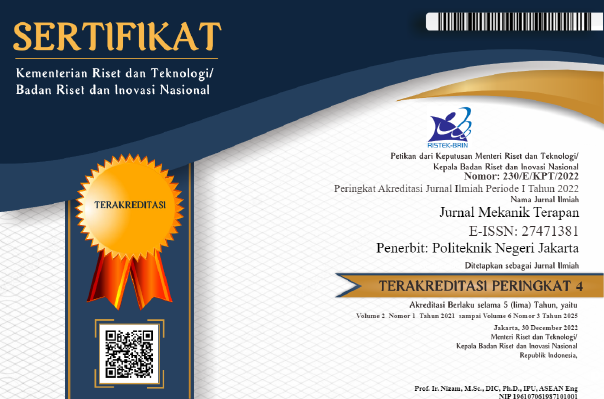Analisis Pengendalian Kualitas Produk Reinforcement Suspension Member Menggunakan Metode Six Sigma
DOI:
https://doi.org/10.32722/jmt.v4i2.5861Keywords:
Six Sigma, DMAIC, Quality, Customer SatisfactionAbstract
Customer satisfaction is the main requirement that must be provided by companies with products that meet the specified specifications, and quality is also a crucial factor in supporting customer satisfaction. The problem identified in this study is the occurrence of defects in reinforcement suspension member products that exceed the company's defect tolerance limit of 0.1%. The aim of this study is to analyze the causes of defects using the Six Sigma method with the DMAIC steps (Define, Measure, Analyze, Improve, and Control), and to propose improvements to address the number of defects that occur. Some of the tools used in this study are the fishbone diagram and the P control chart. The results of this study indicate that the factors causing the failures are the method and environment factors. Meanwhile, the data processing resulted in a DPMO of 2745.21 with a sigma level of 4.28 a process capability index (Cp) of 1.43, and an average defective product rate of 0.28% with a total of 392 defective pieces, while the company's defect tolerance limit is 0.1%. Therefore, the company needs to implement quality control by making improvements to the method and environment factors.
References
A. Suherman and B. J. Cahyana, “Pengendalian Kualitas Dengan Metode Failure Mode Effect And Analysis ( FMEA ) Dan Pendekatan Kaizen untuk Mengurangi Jumlah Kecacatan dan Penyebabnya,” pp. 1–9, 2019.
W. Wahyani, A. Chobir, and D. D. Rahmanto, “PENERAPAN METODE SIX SIGMA DENGAN KONSEP DMAIC SEBAGAI ALAT PENGENDALI KUALITAS,” 2010.
A. Fatah and A. Z. Al-faritsy, “Peningkatan dan Pengendalian Kualitas Produk dengan Menggunakan Metode PDCA (Studi Kasus pada PT. ‘X’),” vol. 3, no. 1, pp. 21–30, 2021.
Y. Suci, Febria, Y. Nasution, Novia, and N. Rizki, Arista, “Penggunaan Metode Seven New Quality Tools dan Metode DMAIC Six Sigma Pada Penerapan Pengendalian Kualitas Produk (Studi Kasus : Roti Durian Panglima Produksi PT. Panglima Roqiiqu Group Samarinda) Used,” vol. 5, no. 1, pp. 530–532, 2017.
A. R. Andriansyah and W. Sulistyowati, “PENGENDALIAN KUALITAS PRODUK CLARISA MENGGUNAKAN METODE LEAN SIX SIGMA DAN METODE FMECA ( Failure Mode And Effect Cricitality Analysis ) ( Studi Kasus : Pt . Maspion III ),” vol. 4, no. 1, pp. 47–56, 2020.
F. Ahmad, “SIX SIGMA DMAIC SEBAGAI METODE PENGENDALIAN KUALITAS PRODUK KURSI PADA UKM,” vol. 6, no. 1, pp. 11–17, 2019.
N. Izzah and M. F. Rozi, “Analisis Pengendalian Kualitas dengan Metode Six Sigma-Dmaic dalam Upaya Mengurangi Kecacatan Produk Rebana pada UKM Alfiya Rebana Gresik,” vol. 7, no. 1, pp. 13–25, 2019.
N. C. Harsoyo and J. Rahardjo, “Upaya Pengurangan Produk Cacat Dengan Metode DMAIC Di PT . X,” J. Titra, vol. 07, no. 1, pp. 43–50, 2019.
B. Harahap, L. Parinduri, A. Ama, and L. Fitria, “ANALISIS PENGENDALIAN KUALITAS DENGAN MENGGUNAKAN METODE SIX SIGMA ( Studi Kasus : PT . Growth Sumatra Industry ),” vol. 3814.
A. Rozi, “ANALISIS PERBAIKAN KUALITAS PADA PRODUKSI PHYTHALITE ANHYDRITE DENGAN PENDEKATAN DMAIC ( Studi Kasus PT . Petrowidada Gresik ),” vol. XVIII, no. 2, pp. 1–13, 2018, doi: 10.350587/matrik.v18i2.583.
R. Hariri, R. Astuti, and M. Ikasari, “PENERAPAN METODE SIX SIGMA UNTUK MENGURANGI PACK DEFECT SUSU GREENFIELDS ( STUDI KASUS PADA PT GREENFIELD , MALANG ) Application of Six Sigma Method for Process Improvement in Reducing Pack Defect of Greenfield Milk ( Case Study in PT Greenfield , Malang ,” vol. 14, no. 2, pp. 141–150, 2013.
N. Fadilah, S. Hastari, and R. Pudyaningsih, “PENGENDALIAN KUALITAS PRODUK SEBAGAI UPAYA MENGKONTROL TINGKAT KERUSAKAN PADA UD. SINDANG KASIH GONDANG WETAN,” vol. 11, no. 2, pp. 1–14, 2019.
Downloads
Published
How to Cite
Issue
Section
License
Copyright (c) 2023 Dewin Purnama, Zulfikar Mutaqin

This work is licensed under a Creative Commons Attribution-ShareAlike 4.0 International License.
Jurnal ini berlisensi Atribut Berbagi Serupa 4.0 Internasional (CC BY-SA 4.0)
Anda diperbolehkan:
- Berbagi — menyalin dan menyebarluaskan kembali materi ini dalam bentuk atau format apapun;
- Adaptasi — menggubah, mengubah, dan membuat turunan dari materi ini untuk kepentingan apapun, termasuk kepentingan komersial.
Berdasarkan ketentuan berikut:
-
Atribusi — Anda harus mencantumkan nama yang sesuai, mencantumkan tautan terhadap lisensi, dan menyatakan bahwa telah ada perubahan yang dilakukan. Anda dapat melakukan hal ini dengan cara yang sesuai, namun tidak mengisyaratkan bahwa pemberi lisensi mendukung Anda atau penggunaan Anda.
-
BerbagiSerupa — Apabila Anda menggubah, mengubah, atau membuat turunan dari materi ini, Anda harus menyebarluaskan kontribusi Anda di bawah lisensi yang sama dengan materi asli.
- Tidak ada pembatasan tambahan — Anda tidak dapat menggunakan ketentuan hukum atau sarana kontrol teknologi yang secara hukum membatasi orang lain untuk melakukan hal-hal yang diizinkan lisensi ini.






